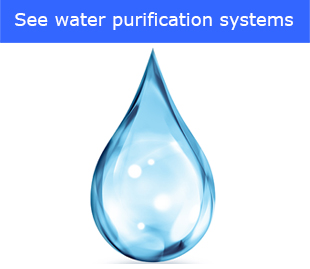How to purify tap water
UK tap water can be quite variable depending on where you are. Whilst it is considered safe to drink everywhere and is considered to be amongst the best in the world, in some areas its very heavily treated, e.g. with chlorine and chloramine, which keep the water safe, but can affect the taste.
As we’re all encouraged to drink more water, water filters and purification systems, which produce “clean” water are becoming more popular.
Clean water also brings other benefits when used for bathing or laundry for example.
There are several methods of obtaining clean water, ranging from simple and cheap, to more complicated and sophisticated systems.
Boiling water to kill germs
The simplest method is to boil water for about 3 -5 minutes, which will kill most of the parasites and germs which are invisible to the naked eye. Boiling for 20 minutes will also remove the chlorine, so improving the small and taste.
Filtering tap water
Filtering water is an effective way to obtain cleaner, fresher tasting water, as it can remove contaminants such as pesticides and chlorine from tap water, without removing the natural salts. Water filtering is a relatively cheap process and there are numerous filtering systems, jugs and kettles available, although filtering isn’t fully effective against viruses.
Distilling water
This is a more complicated process where water is boiled and the steam is passed through a condenser, then cooled back to liquid water. Many of the contaminants which have a higher boiling point are left behind, so this is an effective process but uses a lot of energy and takes time to do, so isn’t usually suitable for producing large quantities of clean water. It also removes minerals, which are good for you!
Reverse Osmosis water purification
Reverse osmosis is a process that forces water through a semi-permeable membrane to remove contaminants. This method will remove viral contamination, bacteria, parasites and micro-organisms, also heavy metals and other contaminants. It produces great tasting water and can even be used to make seawater drinkable.
Reverse osmosis systems are available for home use, with units available to fit under a kitchen sink for example. These do not require expensive fitting methods and are simple to maintain.
Industrial Water purification
Reverse Osmosis systems are widely used in industry, for example we supply systems to bottled water suppliers, breweries and other drinks manufacturers, where it helps to guarantee a consistent taste in the final product. It’s also widely used in food production and bio-pharmaceuticals, as well as in boilers, where the reduced level of contaminants can improve efficiency, and also in aquatic products. RO systems can supply clean water on demand and are, in our view, the most effective way to produce large quantities of clean water. These can be supplied as compact units, which work on mains systems, usually without the need for a pump.
Purified water works well in boilers as there are fewer contaminants to block the workings, and it’s also useful in aquatics, as fish and water organisms are not harmed by the treated water.
Pure water window cleaning is now very popular because it dries without smears or spots, keeps windows clean for longer and, when used with water fed pole systems, makes the process of window cleaning much quicker and safer. Not just for cleaning windows though, this process can be used to clean cars, trucks and a wide range of items where a spot free finish is required.
See more information about pure water window cleaning.
Article by Ian Hodkinson


